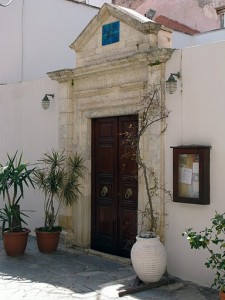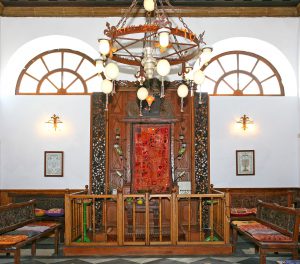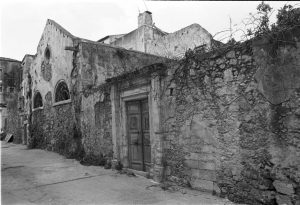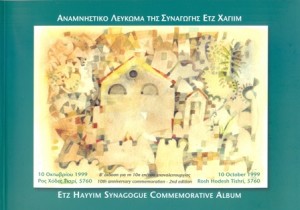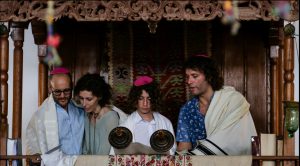The History of Etz Hayyim
The building dates to the 14th-15th centuries and was originally a Venetian Catholic church, the Church of St. Katherine, located in the heart of the small, centuries-old Jewish neighbourhood, Evraiki, situated behind the harbour-front along Kondylaki, Skoufon, Zambeliou and Portou Streets. The church was damaged in the 1540s during one of the Ottoman Turkish attacks on the city led by the Chief Admiral of the Ottoman fleet, Khair ad-Din Kapdian Pasha, otherwise known as Barbarossa. In the mid- to late 17th century, after the eventual Ottoman conquest of Crete (1669), the building was acquired by Hania’s Jewish community who then converted it into a synagogue. Prior to the Second World War, Kal Kadosh Etz Hayyim, a Romaniote synagogue, together with Beth Shalom (bombed in 1941), a Sephardic synagogue, served the needs of Hania’s Jewish community. Once this community was deported in 1944, Etz Hayyim was looted and desecrated and then occupied by squatters until the mid-1950s. From that time until the mid-1990s, the derelict synagogue served as a repository of neighbourhood rubbish, and invariably as a chicken pen, dog kennel and storeroom.
The Renovation and Revival of Etz Hayyim 1996-1999
Having stood abandoned for almost 50 years following the end of the Second World War, the fortunes of Etz Hayyim were about to change as a result of the intervention by Hania resident, Nikos Stavroulakis (himself an artist, writer, academic and founding director of the Jewish Museums of of Athens and Thessaloniki) who wanted to rebuild and revive the synagogue after surveying extensive earthquake damage caused to the building in 1995. Soon afterwards, Nikos gave a lecture about Etz Hayyim at a symposium jointly sponsored by the World Monuments Fund and the Jewish Heritage Program in New York. As a result, Etz Hayyim was added to the prestigious list of the world’s “100 Most Endangered Sites” of international cultural concern compiled by the World Monuments Fund in 1996. With this recognition, Nikos acquired the funding to fully restore the synagogue, a process which took three years and was headed by Nikos himself under the aegis of the World Monuments Fund in cooperation with the Central Board of Jewish Communities in Greece (KISE). Funding was provided by the Rothschild, Lauder, Rosenberg, Rose and other foundations and donations from interested individuals. The synagogue was officially rededicated on 10 October,1999 with Rabbis Jacob Arar and Isaak Mizan of Athens as the celebrants assisted by Rabbi Yacob Dayan of Salonika. Approximately 350 people were present including members of the various Greek Jewish communities, representatives from the Orthodox and Catholic churches in Hania and local and international dignitaries such as the Hon. Constantine Mitsotakis, the former Prime Minister and President of the New Democracy Party of Greece alongside the German Ambassador to Greece.
Etz Hayyim Synagogue Today
Since 2010, Etz Hayyim has been operated by a non-profit organisation in cooperation with the Central Board of Jewish Communities in Greece (KISE). This non-profit organisation is registered as a charity in Greece and, because Etz Hayyim does not receive any public funding, it raises funds for the maintenance of the synagogue and for the various religious and cultural events to ensure its long-term preservation. Two decades after its rededication, Etz Hayyim has become a fixture in the religious and socio-cultural life of Hania as a place of prayer, study, recollection and reconciliation. It is an active, non-denominational synagogue used for celebrating various Jewish holidays and non-religious cultural events including lectures, concerts and exhibitions. Its small team of staff and volunteers undertake ongoing research into the history of Cretan Jews at the same time as engaging both local and international school groups and teachers as part of the synagogue’s educational outreach program. The synagogue today welcomes Jews of all different backgrounds, as well as non-Jews and as such, Etz Hayyim stands as perhaps the only active reminder of the once multifaith, multicultural society of Hania and Crete.


